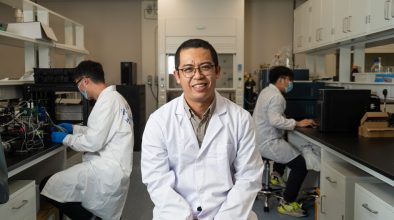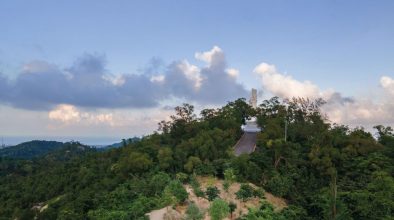Macao’s youth had a voice at the 2022 United Nations Climate Change Conference (COP27), thanks to local NGO Genervision House. Genervision House organised Macao’s first Local Conference of Youth (LCOY) to take place via Zoom in October, with the aim of empowering young people to combat climate change. The two-day virtual event was part of a broader United Nations (UN) initiative taking place in cities around the world, each culminating in a “collective climate change position statement”.
“Most of us have never thought about how we can cope with climate change and contribute ourselves,” said Genervision House co-founder Christy Un, in her opening speech on day one of the LCOY. “We need more people to pay attention to this issue, to find better solutions.”
Un painted a gloomy picture of climate-forward thinking in Macao today. She said responsible production and consumption were “regressing”, and highlighted damage wrought by 2017’s Typhoon Hato – which killed 16 people in the Greater Bay Area – as an example of what extreme weather looks like for the city. For anyone tempted to write Hato off as an outlier, Un pointed out that three out of the seven Signal No. 10 typhoons hitting Macao since 1968 have occurred within the past five years. Rising global temperatures, a hallmark of climate change, are known to make extreme weather events like typhoons more frequent.
Almost 200 people attended the LCOY, just under half of them university students. Nineteen per cent of attendees were secondary school students, and the rest were working professionals. The event featured 11 speakers with backgrounds in law, climate activism, business and academia. They addressed topics ranging from plastic waste, to corporate responsibility, to carbon neutrality. There was general consensus that the city could do more to minimise the effects of climate change, especially when compared with the mainland and other middle-to-high-income parts of the world.
Raising awareness around what climate change means for Macao was a major theme, as was how individuals, corporations and the government can step up. One of the speakers, teaching director in geography for Sacred Heart Canossian College Danny Lu, spoke of his students’ disconnect from the climate: most “just find themselves happy to get a typhoon holiday,” he said. Un said tiny Macao tended to be “a passive city when facing climate change”, relying on bigger players to dictate its future. “We should regard Macao as a city that contributes to, rather than just participates in, the system,” said a third.
Fifty-eight of the conference’s participants co-wrote their collective climate change position statement on day two of the LCOY. Genervision House then submitted this statement to the COP27 negotiations, which drew more than 100 world leaders to Egypt in late November. It allowed the youth of Macao’s unique perspective to be heard alongside views from all over the world.
The position statement was broken down into five sections: action for climate empowerment; climate adaptation; climate change, cities and health; renewable energy; and green industry. Each offered concrete solutions for perceived problems.
The first section noted that while “there is rich biodiversity in Macao with relatively easy access”, many locals were detached from or oblivious to it. Improving people’s connection to Macao’s natural environment could inspire changes in their behaviour, the report proposed.
By making them more aware of how rising temperatures and pollution impact native floral and fauna, for example.
The statement urged Macao’s government to “promote environmentally friendly behaviour through education and financial incentives”. Funding clubs that facilitate nature-based activities and collaborate with schools was one action suggested. Others included subsidising public transport, introducing policies that encourage recycling, and creating a “one-stop-shop platform for climate information” that published regular progress reports on Macao’s efforts towards combating climate change.
In terms of measures the city could take to prepare for increasingly extreme weather, the statement called for nature-based solutions (NBSs) to be incorporated into Macao’s existing disaster prevention plans. Mangroves are an example of an NBS for tidal flood control (they also absorb carbon and boost biodiversity). The ‘sponge city’ model – a Chinese invention – is an NBS for flooding due to rainfall, where excess water is captured, contained, and repurposed through the likes of permeable pavements and underground storage tanks.
The statement said more academic research needs to go into which climate adaptation measures were best suited to Macao, including how people could live both comfortably and sustainably with more extreme temperatures. It noted that buildings constructed without consideration for the climate emit excessive carbon through inefficient heating and cooling. Developing and enforcing green building standards was one way to future-proof the city, according to the statement.
Along with incentivising greener construction, the statement proposed developing the city’s ‘brownfields’ (abandoned tracts of land) into public greenspaces that would act as carbon sinks. It also wanted to make Macao more pedestrian and bike-friendly, as cars are a major source of carbon emissions.
The statement acknowledged that China Southern Power Grid (which supplies the bulk of Macao’s electricity) already uses 50 per cent renewable energy. It also praised the government for running bus stop signs off solar power, but urged it to expand its use of locally generated solar power. The statement suggested making rooftop solar panels mandatory for new builds.
Its final part linked the greening of industries to the broadening of Macao’s job market (a local government goal). Currently, the statement said, the public’s understanding of what being a green business means is limited. “Many incorrectly think that it is just a traditional industry that has a direct connection to the sale of eco-friendly products and the provision of clean energy,” it read. A more accurate definition is that a business is green if it strives to minimise its negative impact on the environment. If more industries in Macao took that approach, there would be more job opportunities in fields such as waste management, environmental science, renewable energy, landscape architecture and sustainability.
The collective statement – edited by Genervision House – was unequivocal in its urgency. “It is clear that the older generations have failed to protect the planet, and the youth will have to pay with their futures,” it read. “As the largest generation of youth in history and leaders of tomorrow, we have to scale up our efforts to protect our only home and our future.”



